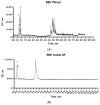The Quantitative Measurement of Peptidoglycan Components Obtained from Acidic Hydrolysis in Gram-Positive and Gram-Negative Bacteria via Hydrophilic Interaction Liquid Chromatography Coupled with Mass Spectrometry
- PMID: 37763978
- PMCID: PMC10534856
- DOI: 10.3390/microorganisms11092134
The Quantitative Measurement of Peptidoglycan Components Obtained from Acidic Hydrolysis in Gram-Positive and Gram-Negative Bacteria via Hydrophilic Interaction Liquid Chromatography Coupled with Mass Spectrometry
Abstract
The high throughput in genome sequencing and metabolic model (MM) reconstruction has democratised bioinformatics approaches such as flux balance analysis. Fluxes' prediction accuracy greatly relates to the deepness of the MM curation for a specific organism starting from the cell composition. One component is the cell wall, which is a functional barrier (cell shape, exchanges) with the environment. The bacterial cell wall (BCW), including its thickness, structure, and composition, has been extensively studied in Escherichia coli but poorly described for other organisms. The peptidoglycan (PG) layer composing the BCW is usually thinner in Gram- bacteria than in Gram+ bacteria. In both bacteria groups, PG is a polymeric mesh-like structure of amino acids and sugars, including N-acetylglucosamine, N-acetylmuramic acid, and amino acids. In this study, we propose a high-throughput method to characterise and quantify PG in Gram-positive and Gram-negative bacteria using acidic hydrolysis and hydrophilic interaction liquid chromatography coupled with mass spectrometry (HILIC-MS). The method showed a relatively short time frame (11 min analytical run), low inter- and intraday variability (3.2% and 4%, respectively), and high sensitivity and selectivity (limits of quantification in the sub mg/L range). The method was successfully applied on two Gram-negative bacteria (Escherichia coli K12 MG1655, Bacteroides thetaiotaomicron DSM 2079) and one Gram-positive bacterium (Streptococcus salivarius ssp. thermophilus DSM20259). The PG concentration ranged from 1.6% w/w to 14% w/w of the dry cell weight. The results were in good correlation with previously published results. With further development, the PG concentration provided by this newly developed method could reinforce the curation of MM.
Keywords: HILIC-MS; biomass composition analysis; glucosamine; hydrolysis; muramic acid; n-acetylglucosamine; n-acetylmuramic acid; peptidoglycan.
Conflict of interest statement
The authors declare no conflict of interest.
Figures








References
-
- Schumann P. Methods in Microbiology. Volume 38. Elsevier; Amsterdam, The Netherlands: 2011. Peptidoglycan Structure; pp. 101–129.
Grants and funding
LinkOut - more resources
Full Text Sources
Molecular Biology Databases

